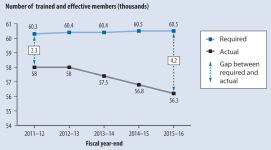I wonder how much things have improved since this audit in 2016, and who will get fired if there's been no improvement


Report 5—Canadian Armed Forces Recruitment and Retention—National Defence
Findings, Recommendations, and Responses
Reaching targets
Overall message
5.11Overall, we found that the total number of Regular Force members had decreased, and that there had been a growing gap between the number of members needed and those who were fully trained. In our opinion, it is unlikely that the Regular Force will be able to reach the desired number of members by the 2018–19 fiscal year as planned. We also found that although the Canadian Armed Forces had established a goal of 25 percent for the representation of women, it did not set specific targets by occupation, nor did it have a strategy to achieve this goal.
5.12We found that although the Regular Force had mechanisms in place to define its recruiting needs, those needs were not reflected in recruitment plans and targets. Instead, recruitment targets were based on National Defence’s capacity to process applications and enrol and train new members. Furthermore, we found that the total recruitment targets had been met by enrolling more members than had been set as targets in some occupations, leaving other occupations significantly below the required number of personnel.
5.13This is important because the Canadian Armed Forces needs a sufficient number of trained members in the right balance of occupations to maintain its military capability and accomplish the missions set out in the
Canada First Defence Strategy.
What we concluded
We concluded that the Canadian Armed Forces implemented systems and practices to recruit, train, and retain the members it needed, but, as noted in this report, many of these systems and practices did not meet its needs or achieve its objectives.
Recruiting targets were set below the Regular Force’s needs. For certain occupations, insufficient numbers of applicants were attracted and processed. In addition, the process placed more emphasis on the Canadian Armed Forces’ timelines and capacities than on applicants’ needs, contributing to some prospective employees leaving the process and others being rejected. Once applicants are enrolled as members, lengthy training times can lead to frustration and attrition, so it is important to track new members with the goal of improving timeliness. Although the Regular Force knew the causes of attrition, it had not implemented or revised its most recent retention strategy.
In order to achieve the required number of trained members across occupations, the Regular Force must examine its methods of attracting and recruiting candidates, and training and retaining members. It must manage all phases of the process for each occupation. It should tailor and implement different approaches for each occupation to address each occupation’s unique challenges.
What we found
Reaching targets
Overall, we found that the total number of Regular Force members had decreased, and that there had been a growing gap between the number of members needed and those who were fully trained. In our opinion, it is unlikely that the Regular Force will be able to reach the desired number of members by the 2018–19 fiscal year as planned. We also found that although the Canadian Armed Forces had established a goal of 25 percent for the representation of women, it did not set specific targets by occupation, nor did it have a strategy to achieve this goal.
We found that although the Regular Force had mechanisms in place to define its recruiting needs, those needs were not reflected in recruitment plans and targets. Instead, recruitment targets were based on National Defence’s capacity to process applications and enrol and train new members. Furthermore, we found that the total recruitment targets had been met by enrolling more members than had been set as targets in some occupations, leaving other occupations significantly below the required number of personnel.
This is important because the Canadian Armed Forces needs a sufficient number of trained members in the right balance of occupations to maintain its military capability and accomplish the missions set out in the Canada First Defence Strategy.
Getting and developing the right people
Overall, we found that the Regular Force was unable to attract a sufficient number of qualified applicants for some occupations. Recruiters did not always have the support needed to provide the necessary information to applicants. We also found that certain practices in the recruitment process prevented qualified candidates from being enrolled. Once recruits were enrolled, they had minimal waiting times for basic training, but they had considerable waiting times for some occupational training. In addition, the Regular Force lacked sufficient mechanisms to oversee members’ progress in training programs.
This is important because the manner in which the process for applicants is carried out and new recruits are trained has a large impact on how long they will stay in the Canadian Armed Forces. It is also more cost-effective to keep applicants and new trainees in the process, rather than to lose them and have to start over with new members.
Keeping the right people
Overall, we found that the Regular Force experienced high levels of attrition in some occupations. Although it knew the causes of attrition, the Regular Force had not implemented its most recent overall retention strategy, nor had it developed specific strategies to respond to the challenges of each occupation.
This finding matters because the military’s operational capability depends on the Canadian Armed Forces’ ability to retain highly specialized, trained, and experienced military personnel on a long-term basis. It is also important because training and developing people is expensive, particularly in certain occupations; it is therefore more cost-effective for National Defence if, once trained, members stay with the Canadian Armed Forces.

